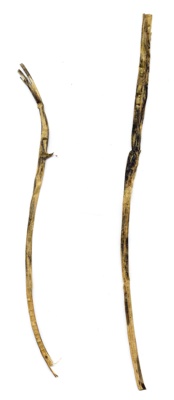Diseases
Colletotrichum trifolii Bain et Essary . Anthracnose of Alfalfa.
Taxonomic position.
Class Deuteromycota, superorder Ceolomycetes, order Melanconiales, family Melanconiaceae, genus Colletotrichum.Biological group.
Hemibiotroph.Morphology and biology.
The disease affects all above-ground organs of plants, mainly petioles and leaves. Spots black or brown; on leaves they are small to very large, often embracing the entire leaf plate, irregular, often angular; on stems the spots are elongated, depressed, pale to light-brown or gray in the center. Beds are scattered or aggregated in groups, having numerous or few setae; the setae are dirty-brown, paler at apex, often wavy-curved or nodulose, 39-62 x 4-7 microns in size. Conidia are cylindrical, colorless, rounded at both apices, 11-13 x 3-4 microns in size. Sources of the infection are infected seeds and vegetation residues. The fungus spreads by conidia during vegetation. In Russia it can affect Trifolium pratense L. and Ornithopus sativus L., les often Medicago sativa L.Distribution.
The Anthracnose is distributed in the USA, Canada, South America, European countries (former Yugoslavia, Bulgaria, France, Czechia, and Slovakia). In the territory of the former USSR the fungus is found in the Non-Chernozem zone only.Ecology.
Warm damp weather with frequent rains is favorable for disease development.Economic significance.
In Europe, USA, and Canada the Anthracnose causes appreciable damage to alfalfa, causing destruction of shoots, reduction of green yield, deterioration of quality and formation of puny light-weight seeds. In Russia and adjacent countries the disease has no economic significance. Control measures include destruction of vegetation residues, autumn plowing, seed dressing, maintenance of crop rotation, treatment of seed crops by fungicides, harvesting on optimum dates, growing healthy seed material, use of resistant varieties.Reference citations:
Blazhev V. 1977. Anthracnose of Alfalfa. Rasteniev.dni nauki (Sofiya) 14(5): 119-123 (in Bulgarian).Grau C.R., Arny D.C., Nygaard S.L. 1989. Assessment of Alfalfa cultivar reaction to anthracnose in controlled and field environments. In: C.W. Horne, ed. Plant Diseases 73(2): 167-170.
Khokhryakova T.M., Polozova T.L., Vakhrusheva T.E. 1984. Keys to fodder plant diseases. Leningrad: Kolos, 200 p. (in Russian).
Pidoplichko N.M. 1977. Fungal parasites of cultural plants. Guide, vol.2. Kiev: Naukova Dumka, 299 p. (in Russian).
Robotic V., Klokocar-Smit Z. 1983. Colletotrichum trifolii Bain i Essary on alfalfa. In: L. Vasiljevi, ed. Zastita bilja. Beograd: Institut za Zastitu bilja, Vol. 34(2). Br. 164. p. 225-239 (in Serbian).
Vasil'evskii N.I., Karakulin B.P. 1950. Parasitic imperfect fungi. Part 2. Melanconiaceae. Moscow & Leningrad: AN SSSR, 680 p. (in Russian).


